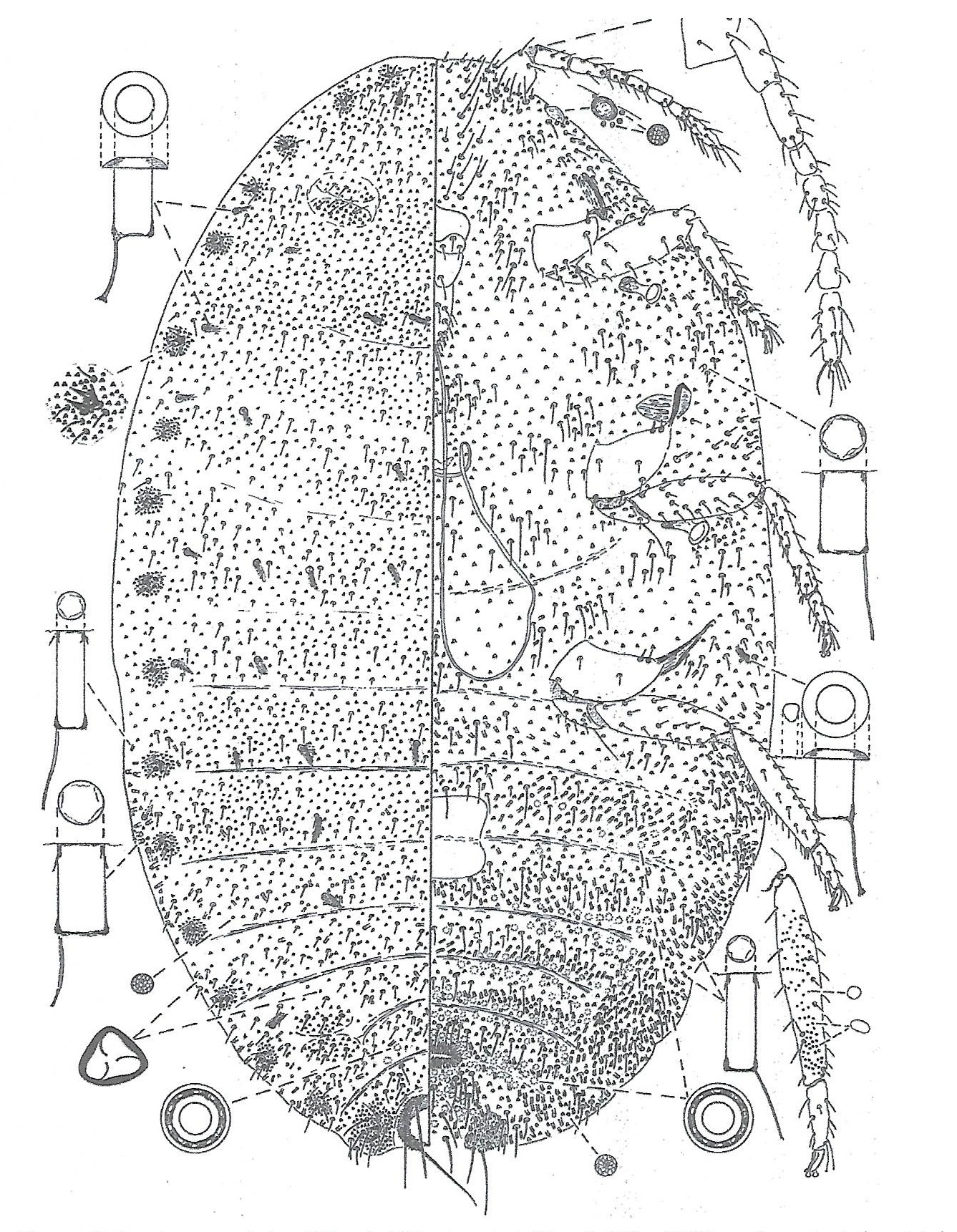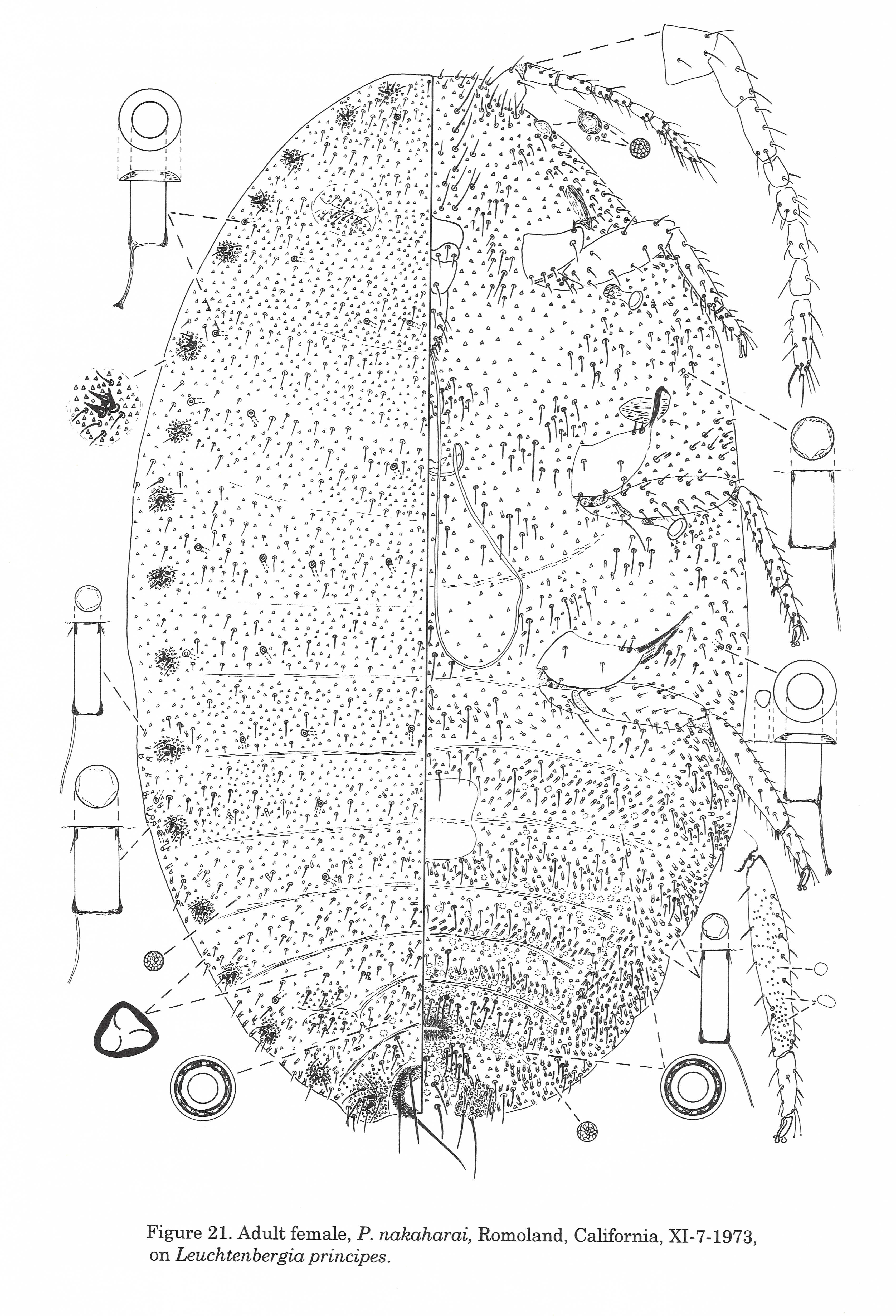Valid Names Results
Pseudococcus nakaharai Gimpel & Miller, 1996 (Pseudococcidae: Pseudococcus)Nomenclatural History
- Pseudococcus nakaharai Gimpel & Miller 1996: 87. Type data: MEXICO: San Luis Pt., on Echinocactus durango. Holotype, female, Type depository: Washington: United States National Entomological Collection, U.S. National Museum of Natural History, District of Columbia, USA; accepted valid name Illustr.
Common Names
- Nakahara mealybug GimpelMi1996
Ecological Associates
Hosts:
Families: 9 | Genera: 39
- Araceae
- Philodendron | GimpelMi1996
- Cactaceae
- Acanthocereus | GimpelMi1996
- Ariocarpus | GimpelMi1996
- Ariocarpus retusus | GimpelMi1996
- Ariocarpus trigonus | GimpelMi1996
- Astrophytum | GimpelMi1996
- Astrophytum asterias | JansenAl2023
- Astrophytum myriostigma | GimpelMi1996
- Astrophytum ornatum | GimpelMi1996
- Carnegiea | GimpelMi1996
- Carnegiea gigantea | LiLiWa2018
- Cephalocereus | GimpelMi1996
- Cephalocereus columna-trajani | GimpelMi1996
- Cephalocereus senilis | GimpelMi1996
- Cereus | GimpelMi1996
- Coryphantha | GimpelMi1996
- Coryphantha durangensis | GimpelMi1996
- Coryphantha elephantidens | GimpelMi1996
- Coryphantha ottonis | GimpelMi1996 | (= Coryphantha asterias)
- Echinocactus | GimpelMi1996
- Echinocactus grusonii | GimpelMi1996
- Echinocereus schmollii | GimpelMi1996 | (= Wilcoxia schimoll)
- Ferocactus | GimpelMi1996
- Ferocactus glaucescens | GimpelMi1996
- Ferocactus schwarzii | JansenAl2023
- Glandulicactus | GimpelMi1996
- Leuchtenbergia | GimpelMi1996
- Leuchtenbergia principis | GimpelMi1996
- Lophophora | GimpelMi1996
- Lophophora williamsii | GimpelMi1996
- Mammillaria | GimpelMi1996
- Mammillaria candida | GimpelMi1996
- Mammillaria parkinsonii | GimpelMi1996
- Mammillaria rhodantha | GimpelMi1996 | (= Mammillaria calacantha)
- Marginatocereus marginatus | GimpelMi1996
- Melocactus | JansenAl2023
- Myrtillocactus | JansenAl2023
- Neobuxbaumia polylopha | GimpelMi1996
- Neomammillaria candida | GimpelMi1996
- Neoraimondia herzogiana | JansenAl2023
- Obregonia | GimpelMi1996
- Obregonia denegrii | GimpelMi1996
- Opuntia | GimpelMi1996
- Opuntia microdasys | GimpelMi1996
- Pachycereus | GimpelMi1996 | (= Lemaireocereus)
- Parodia | GimpelMi1996 | (= Notocactus)
- Parodia leninghausii | GimpelMi1996
- Pilosocereus leucocephalus | GimpelMi1996
- Polaskia | JansenAl2023
- Sclerocactus uncinatus | GimpelMi1996
- Stenocactus | GimpelMi1996
- Stenocereus montanus | VonEll2025
- Stenocereus pruinosus | GimpelMi1996 | (= Lemaireocereus pruinosus)
- Thelocactus | GimpelMi1996
- Thelocactus bicolor | GimpelMi1996
- Thelocactus conothelos | GimpelMi1996
- Crassulaceae
- Echeveria | GimpelMi1996
- Ebenaceae
- Diospyros kaki | PachecKaMa2017
- Euphorbiaceae
- Euphorbia tirucalli | JansenAl2023
- Fouquieriaceae
- Fouquieria | GimpelMi1996
- Fouquieria fasciculata | GimpelMi1996
- Orchidaceae
- Chysis aurea | GranarGo2018
- Maxillaria | GimpelMi1996
- Rosaceae
- Cydonia oblonga | GranarGo2018
- Vitaceae
- Vitis | GranarGo2018
Geographic Distribution
Countries: 8
- Canary Islands | JansenAl2023
- Germany | JansenAl2023
- Guatemala | GimpelMi1996
- Japan | GimpelMi1996
- Mexico | GimpelMi1996
- Netherlands | JansenAl2023
- Peru | GranarGo2018
- United States
- California | GimpelMi1996
- District of Columbia | GimpelMi1996
- Florida | GimpelMi1996
- Texas | GimpelMi1996
Keys
- GranarGo2018: pp.10-14 ( Adult (F) ) [Central & South American Pseudococcus]
- LiLiWa2018: pp.538-539 ( Adult (F) ) [Species of Pseudococcus]
- PachecKaGe2016a: pp.77 ( Adult (F) ) [Pseudococcus maritimus complex with multilocular disc pores present on dorsum]
- VonEllWa2016: pp.74-75 ( Adult (F) ) [Pseudococcus species present in the New World]
- GimpelMi1996: pp.19, 20 ( Adult (F) ) [World]
- GimpelMi1996: pp.137 ( Immature (F) ) [World]
Remarks
- Systematics: Pseudococcus nakaharai is different from all other members of the P. maritimus group. It susperficially resembles P. viburni by having: Swollen hind tibiae with numerous translucent pores; several discoidal pores near each eye; several oral collars near cererius 12, few or no oral collars associated with cerarii 10 and 11. It differs by having 33(28-36) trilocular pores and 4(3-6) discoidal pores associated with cerarius 12; dorsal oral-collar tubular ducts; dorsal multilocular disc pores; longest dorsal body seta 24(21-34µ long; longest dorsal seta on segment VIII. P. viburni has 19(15-23) trilocular pores and 2(1-3) discoidal pores associated with cerarius 12; no dorsal oral collars except marginal ones; no dorsal multilocular disc pores; longest dorsal body seta 15(10-20)µ long. (Gimpel & Miller, 1996)
- Structure: Translucent pores restricted to hind tibiae; hind tibiae swollen mesally; oral-collar tubular ducts present on posterior abdominal segments of dorsum; multilocular disc pores usually present dorsally on mediolateral area of segment VII; 7(6-11) cisvulvar setae on each side; labium 248(219-297)µ long. (Gimpel & Miller, 1996)
- General Remarks: Good description and illustration of the adult female given by Gimpel & Miller (1996). Good description and illustration of the third instar female given by Gimpel & Miller (1996).
Illustrations
Citations
- DowellGiJe2016: distribution, 119
- GimpelMi1996: description, host, illustration, taxonomy, 87-93, 152-154
- GranarGo2018: diagnosis, distribution, illustration, key, taxonomy, 7-14, 35-36
- JansenAl2023: dispersal, host, 30,36
- LiLiWa2018: diagnosis, distribution, host, illustration, morphology,
- PachecKaMa2017: DNA sequencing, distribution, host, 3
- VonEll2025: distribution, host, 33
- VonEllWa2016: key, 75




